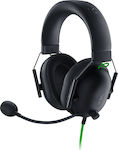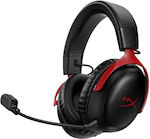Summary:
It is a pretty good quad microphone, with good sound quality and a beautiful design. It's a bit expensive, but the price has already dropped by half since it was released, as it now has the new QuadCast S model.
Condenser vs Dynamic Microphone:
There is a difference between condenser and dynamic microphones.
* Dynamic microphones only pick up loud sounds and are commonly used by singers in live performances or interviews. Dynamic microphones are usually found in headsets because they are right next to your mouth and do not pick up other sounds or interference from breathing, etc. They mainly pick up sounds from up close and loud sounds, so they are essentially only for vocals.
* This microphone is a condenser microphone and can pick up all the sounds around it at close or far distances. It can even pick up ambient noise depending on the intensity you set it to, which I will explain further below.
In other words, condenser microphones are overall versatile microphones. You can use them to record music from your guitar or a small choir singing from a distance around it.
Appearance:
It is beautiful with red LED lighting. It comes ready on its base and you don't need to do anything else other than connecting it to your computer.
At the back, it has a knob that you can turn according to the desired recording settings. Just below this knob, there is the USB connection and the headphone jack.
At the bottom of the microphone, there is the microphone volume control.
At the top, there is a touch-sensitive area that allows you to mute/unmute the microphone. When you mute it, the light also turns off, while it turns on when you unmute it. This way, you know if it is listening or not, and you can turn off the light if you don't want it to illuminate when not in use.
Base:
It is quite good and functional. You can adjust the angle of the microphone to better face your mouth. The package also includes a smaller base that you can use if you want to mount the microphone on an arm. Additionally, as you can see in the photos, it is shock-mounted with rubber to eliminate any vibrations from the base to the microphone.
Headphone Jack:
Once you initially connect the microphone to your computer, it will automatically install the software and change your default sound settings. The microphone also has an audio output, which means you can connect your headphones to it and listen to computer sounds from there. I do not recommend this; it is better to leave the sound on the computer's regular output at the back. I don't know if it distorts the sound at all, but why take the risk.
NOTE: If your speakers are connected to the computer's regular motherboard jack, you can use Windows to disable microphone playback through the speakers (even when recording and in use). We do this to avoid feedback, especially if the speakers and microphone are close together or if the speakers are very loud. However, if you connect the speakers directly to the microphone's audio output, they will output both the Windows sounds and the microphone sounds, and there is no way to disable playback.
----- Voice Filter:
There is no need to add an additional voice pop filter in front (that round foam they put between the microphone and the mouth), it already has one. Inside the cage-like metal casing, there is an acoustic foam that removes clicks that you can make with your voice on specific consonants and sounds (such as the letter "p", "f", "s", etc.) and from what I saw, it does its job quite well.
----- Voice Volume:
I would suggest checking yourself speaking from the distance you usually have it and setting it to the lowest volume needed to sound clear. Do not put it on maximum, thinking that the sound will be better, as it may distort if you are too close or speak loudly. I say this because as a condenser microphone, you don't want it to pick up even the sound of your computer's fans that will be close to it or any creaking from the next room. It is very difficult to achieve complete isolation from all sounds in the environment unless you have it in a soundproofed room with foam for recordings. But as I said, that's how condenser microphones are.
----- Function Button (knob on the back):
The microphone is quadruple, meaning it has 4 microphones inside. The settings it has are as follows:
* Stereo (has the symbol of infinity ∞), produces stereo sound, not very good for Discord, etc., as the listener may hear your voice more from one ear. A good use would be for ASMR videos.
* Circle, it precisely captures the same monophonic sound around it in 360 degrees, good for voice especially when you have more than one person or if you constantly change positions.
* Cardioid, I don't know what the symbol is, but it looks like a thick heart. This is the best for an individual, meaning instead of using the 360 degrees of the circle, you use this one that mainly captures what is in front of the microphone, so if you have your computer on the other side, it won't pick up any noise.
* Bidirectional, this is the opposite of stereo from what I understood, meaning it captures a different sound from the front and from the back. I haven't tried it, I just read it in a review. It probably creates a stereo sound that simply captures from the front and back, not from the right and left. Its use is if you have two speakers and you want each one to have their own audio channel. I assume again that it would have exactly the same function if you used stereo and turned it to the sides, so that the two speakers are on the right and left of the microphone, but I'm not 100% sure.
----- Difference with QuadCast S:
It's the same, just the "S" version has RGB lighting instead of plain red and it has a connection with the NGenuity program where you can change its color and control its functions through the program. For me, there is absolutely no difference, I prefer to handle it directly from its physical interface rather than opening a program to control it, especially if I'm doing something on the computer and have the microphone in front of me, it is much more practical to simply turn a knob on the microphone rather than searching for options within a program.
----- Difference with SoloCast and DuoCast:
Solo vs Duo vs Quad... single vs double vs quadruple, that is. The Solo is a monophonic microphone, the Duo is also stereo, while the Quad has 4 microphones as I mentioned above.
----- Notes:
It does not have a 3.5mm audio jack, it only connects via USB. For some, this may be an issue if they want to use it on a device that only has a jack input. Obviously, it works perfectly on the computer, PS4, and Mac. It doesn't work on Xbox from what I have read, but Microsoft should look into that, it's not the microphone's fault. I'm just mentioning it so you don't get it for a specific reason and it doesn't work for you.



















































